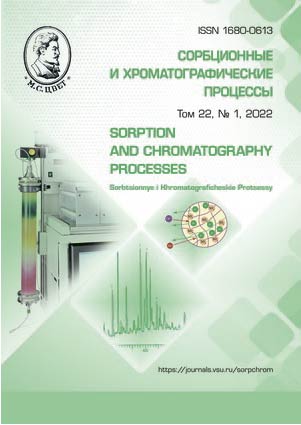Адсорбция метана на графеновом аэрогеле
Аннотация
Статья посвящена изучению адсорбции метана на графеновом аэрогеле в широком интервале давлений при температурах выше критической. В работе синтезирован углеродный наноструктурный материал, представляющий собой аэрогель на основе восстановленного оксида графена с применением сверхкритических методов обработки гидрогеля в среде изопропилового спирта. Полученный адсорбент обладает хорошо развитой пористой структурой (S(БЭТ)=657 м2/г; V(DFT)=0.766 см3/г), что создает хорошие перспективы его использования для адсорбции энергетически важных газов, в частности, метана. Благоприятным фактором для увеличения скорости адсорбции-десорбции в таких системах является большой объем мезопор с диаметрами ~5.0 нм.
Изучена адсорбция метана на полученном графеновом аэрогеле при температурах 298.15, 303.15, 313.15 К и давлении до 100 бар. Максимальная величина адсорбции составила 7.31 ммоль/г при 100 бар и 298.15 К. Представлены результаты расчетов адсорбции метана на графеновом аэрогеле в области сверхкритических температур по теории объемного заполнения микропор М. М. Дубинина. Экспериментальные данные адсорбции метана на графеновом аэрогеле были проанализированы с использованием типовой модели адсорбции Дубинина-Радушкевича в интервале температур 298.15-313.13 К. Характеристическая энергия адсорбции исследуемого газа (метана) на графеновом аэрогеле находятся в диапазоне 5.47-5.64 кДж/моль, что говорит о том, что процесс адсорбции метана на графеновом аэрогеле относится к физической адсорбции. На основе полученных данных рассчитаны зависимости дифференциальных мольных теплот адсорбции метана на графеновом аэрогеле от величины адсорбции при температурах 298.15-313.15 К. Теплота адсорбции составила 24 кДж/моль при всех температурах, а затем падала до ~9 кДж/моль при ~6 ммоль/г (298.15 К) и при ~4 ммоль/г (303.15-313.15 К). Такой ход кривых теплоты адсорбции, вероятно, является следствием особенностей пористой структуры адсорбента – мультимодальностью структуры. С молекулярной точки зрения само падение теплоты адсорбции при высоких заполнениях, по-видимому, связано с нарастанием энергии отталкивания между молекулами в адсорбате на малых расстояниях.
Скачивания
Литература
Liu C.M., Dang Y.Y., Zhou Y.P., Liu J. et al., Adsorption, 2012, Vol. 18, pp. 321-325. DOI: https://10.1007/s10450-012-9403-5.
Gomes V.G., Hassan M.M., Sep. Purif. Technol., 2001, Vol. 24, pp. 189-196. DOI: https://10.1016/S1383-5866(00)00228-8.
Cavenati S., Grande C.A., Rodrigues A.E., J. Chem. Eng. Data, 2004, Vol. 49, pp. 1095-1101. DOI: https://10.1021/je0498917.
Mofarahi M., Gholipour F., Mi-croporous Mesoporous Mater., 2014, Vol. 200, pp. 1-10. DOI: https://10.1016/j.micromeso.2014.08.022.
Ursueguía D., Díaz E., Ordóñez S., Mi-croporous Mesoporous Mater., 2020, Vol. 298, 110048. DOI: https://10.1016/j.micromeso.2020.110048.
Li S., Han K., Li J., Li M. et al., Mi-croporous Mesoporous Mater., 2017, Vol. 243, pp. 291-300. DOI: https://10.1016/j.micromeso.2017.02.052.
Dong F., Lou H., Kodama A., Goto M. et al., Sep. Purif. Technol., 1999, Vol. 16, pp. 159-166. https://doi.org/10.1016/S1383-5866(98)00122-1.
Xia Y., Walker G.S., Grant D.M., Mokaya R., J. Am. Chem. Soc., 2009, Vol. 131, pp. 16493-16499. DOI: https://10.1021/ja9054838.
Goj A., Sholl D.S., Akten E.D., Kohen D., J. Phys. Chem. B, 2002, Vol. 106, pp. 8367-8375. DOI: https://10.1021/jp025895b.
Coasne B., Pellenq R.J.M., J. Chem. Phys., 2004, Vol. 120, pp. 2913-2922. DOI: https://10.1063/1.1632897
Lozano-Castello D., Cazorla-Amoros D., Linares-Solano A., Quinn D.F., Carbon, 2002, Vol. 40, pp. 989-1002. DOI: https://10.1016/S0008-6223(01)00235-4.
Anas M., Unsal S., Erkey C., J. Su-percrit Fluids., 2018, Vol. 141, pp. 166-172. DOI: https://10.1016/j.supflu.2017.11.032.
Dubinin M.M., Adsorbtsiya i poris-tost', M., VAKHZ, 1972, 126 p.
Kel'tsev N.V., Osnovy adsorbtsion-noy tekhniki. 2nd edition, revised and enlarged, M., Nauka Publ., 1984, 592 p.
Dubinin M.M., Adsorbtsiya v mikro-porakh. Pod red. Dubinina M.M., Ser-pinskogo V.V., M., Nauka Publ., 1983, 186 p.
Iruretagoyena Ferrer D. Supported Layered Double Hydroxides as CO2 Adsorbents for Sorption-enhanced H2 Production. Springer Theses, 2014, 209 p. DOI: https://10.1007/978-3-319-41276-4_1.
Sing K.S.W., Everett D.H., Haul R.A.W. et al., Pure Appl Chem., 1985, Vol. 57, pp. 603-619. DOI: https://10.1351/pac198557040603.
Erdogan F.O., Journal of Textiles and Engineer, 2017, Vol. 24, pp. 181-187. DOI: https://10.7216/1300759920172410706.








